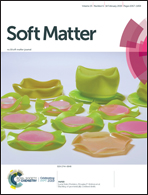Universal localization transition accompanying glass formation: insights from efficient molecular dynamics simulations of diverse supercooled liquids†
Abstract
The origin of the precipitous dynamic arrest known as the glass transition is a grand open question of soft condensed matter physics. It has long been suspected that this transition is driven by an onset of particle localization and associated emergence of a glassy modulus. However, progress towards an accepted understanding of glass formation has been impeded by an inability to obtain data sufficient in chemical diversity, relaxation timescales, and spatial and temporal resolution to validate or falsify proposed theories for its physics. Here we first describe a strategy enabling facile high-throughput simulation of glass-forming liquids to nearly unprecedented relaxation times. We then perform simulations of 51 glass-forming liquids, spanning polymers, small organic molecules, inorganics, and metallic glass-formers, with longest relaxation times exceeding one microsecond. Results identify a universal particle-localization transition accompanying glass formation across all classes of glass-forming liquid. The onset temperature of non-Arrhenius dynamics is found to serve as a normalizing condition leading to a master collapse of localization data. This transition exhibits a non-universal relationship with dynamic arrest, suggesting that the nonuniversality of supercooled liquid dynamics enters via the dependence of relaxation times on local cage scale. These results suggest that a universal particle-localization transition may underpin the glass transition, and they emphasize the potential for recent theoretical developments connecting relaxation to localization and emergent elasticity to finally explain the origin of this phenomenon. More broadly, the capacity for high-throughput prediction of glass formation behavior may open the door to computational inverse design of glass-forming materials.

- This article is part of the themed collection: Soft Matter Emerging Investigators


 Please wait while we load your content...
Please wait while we load your content...